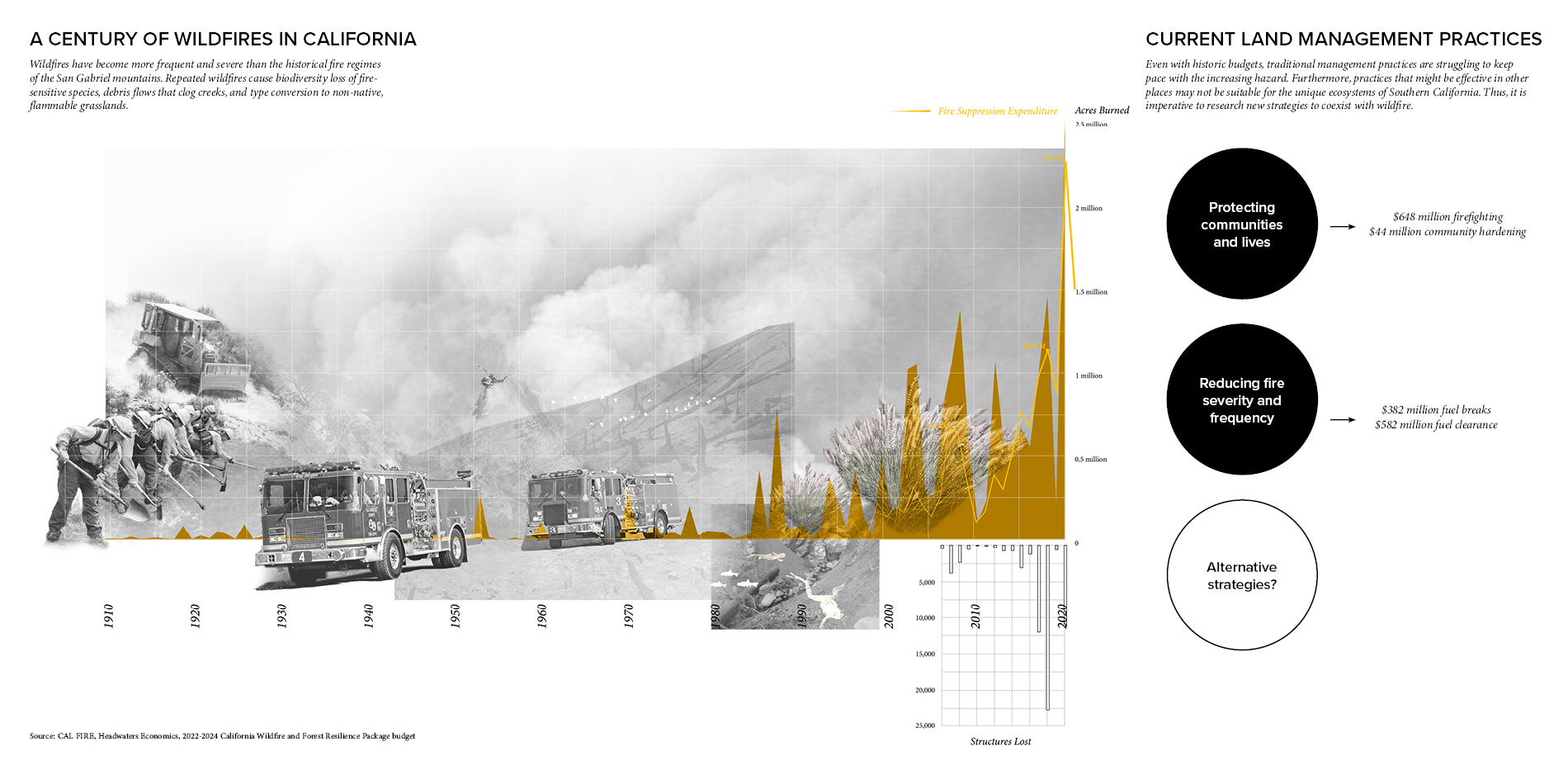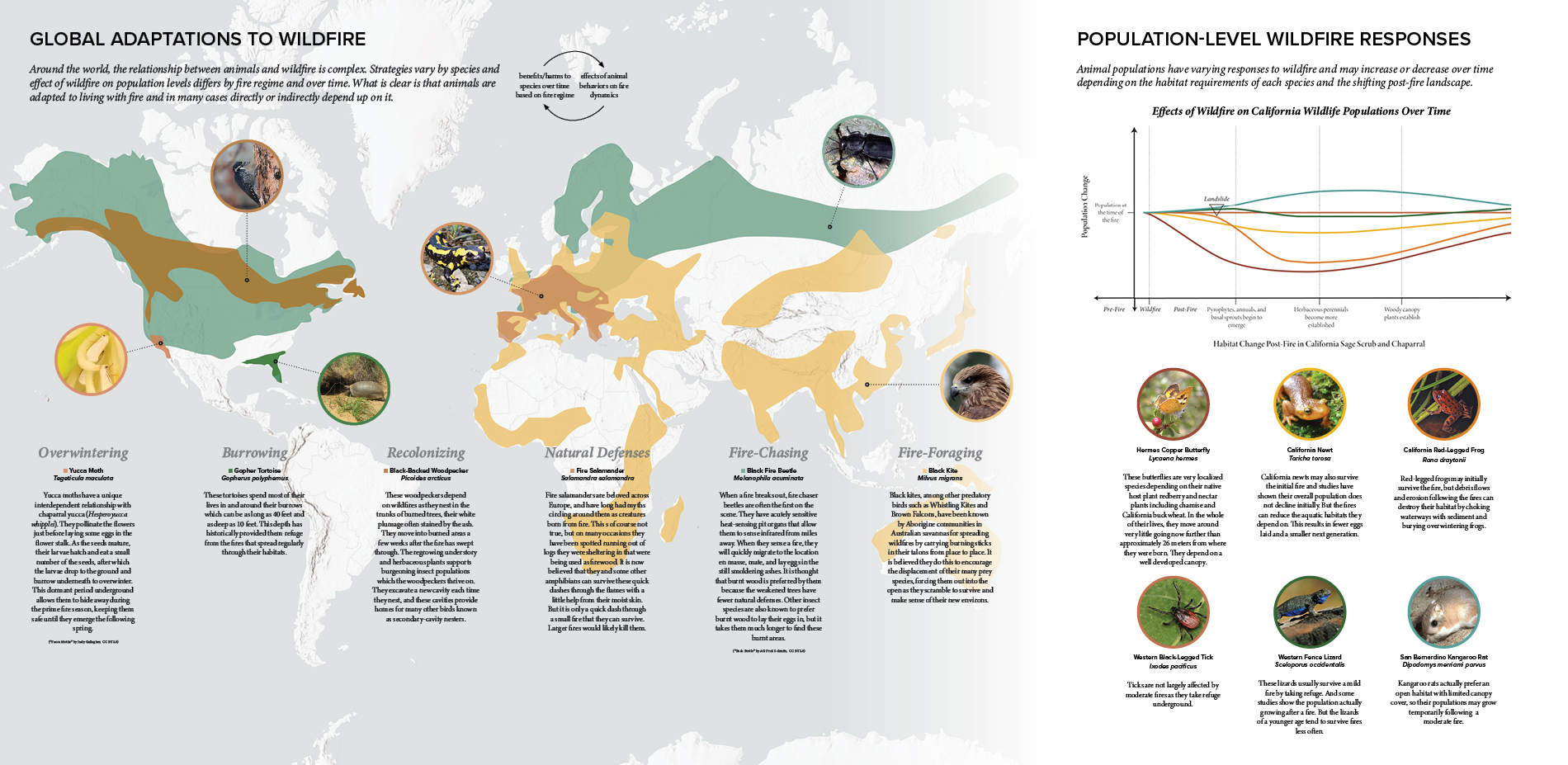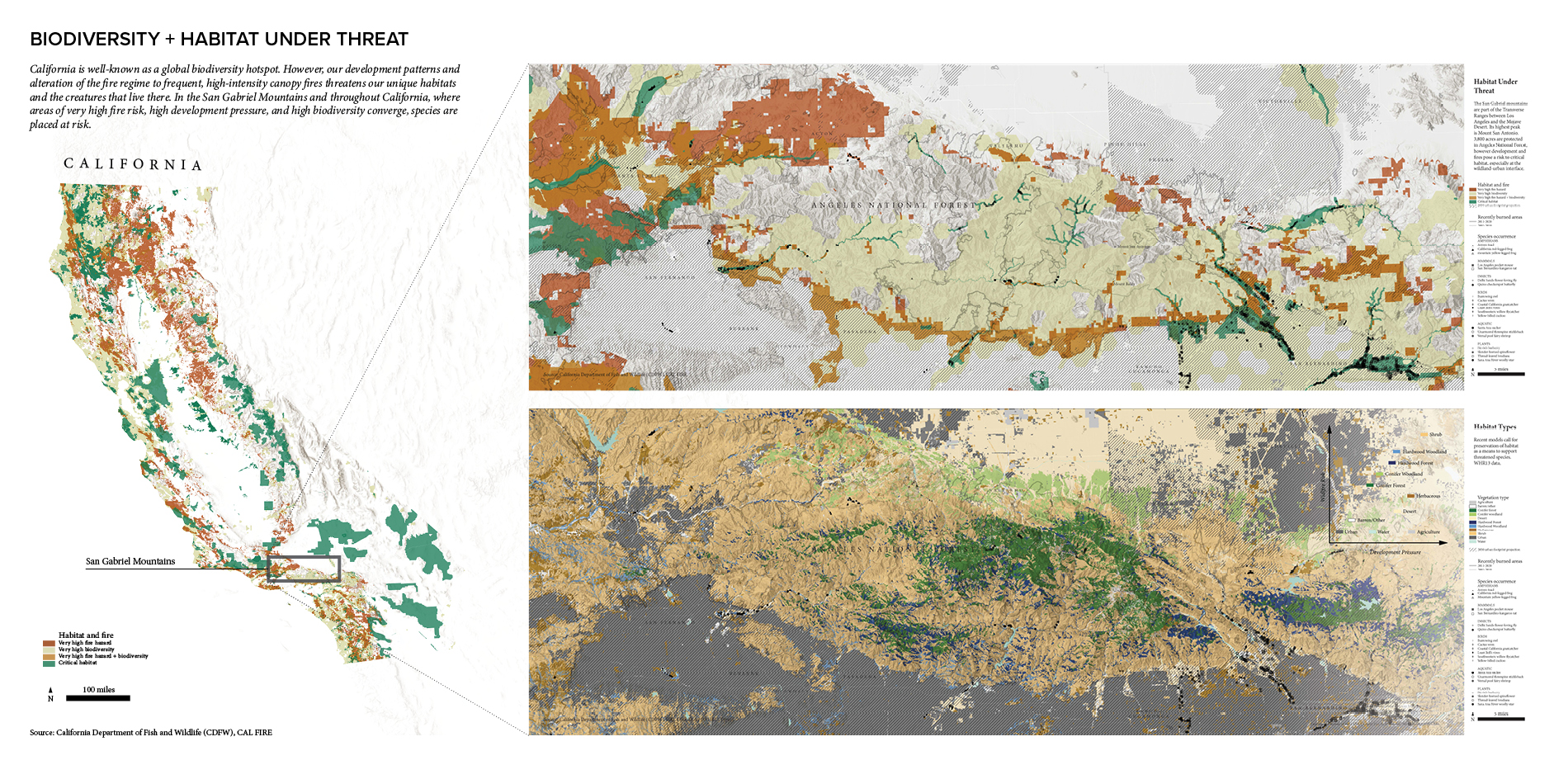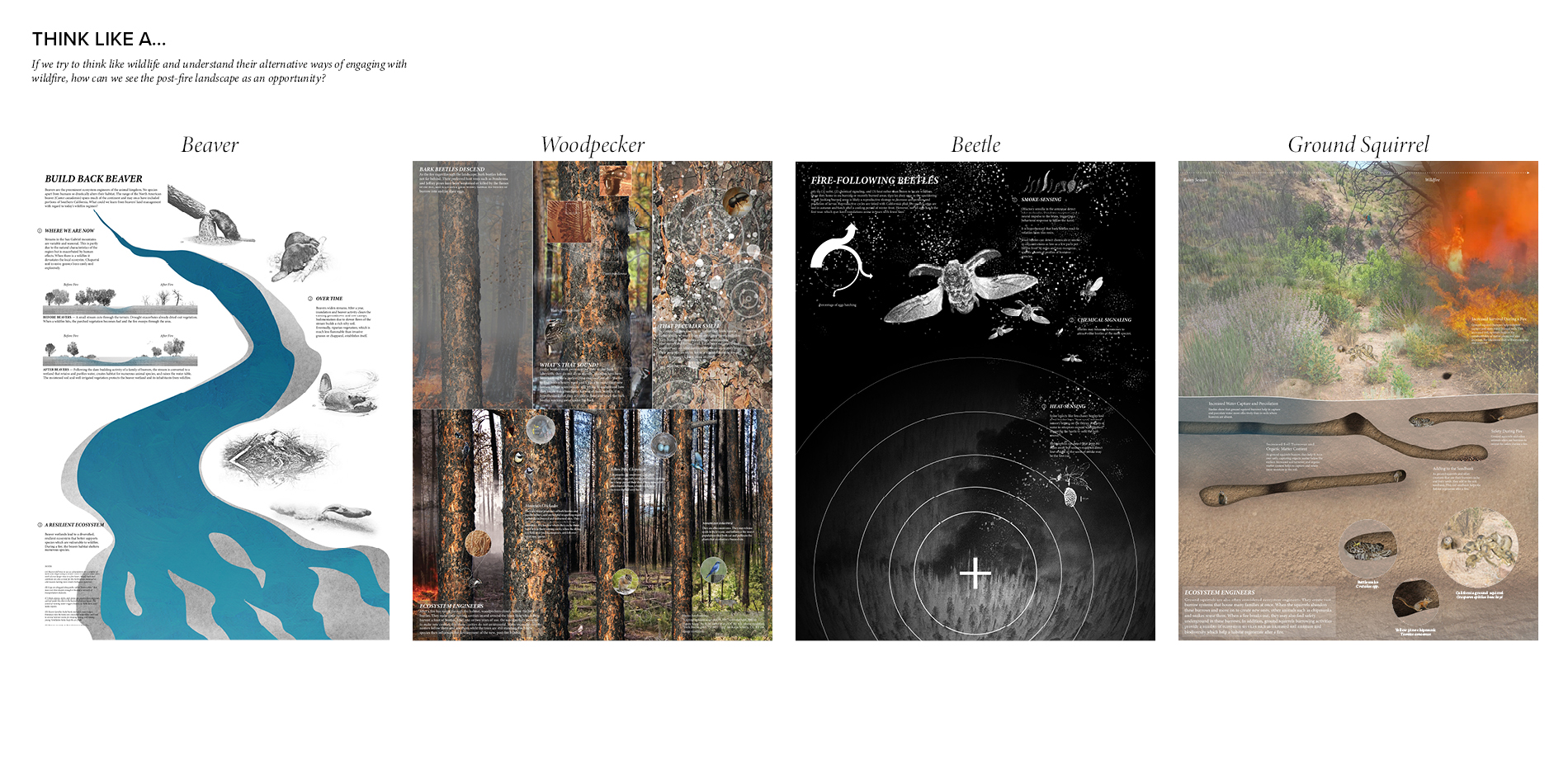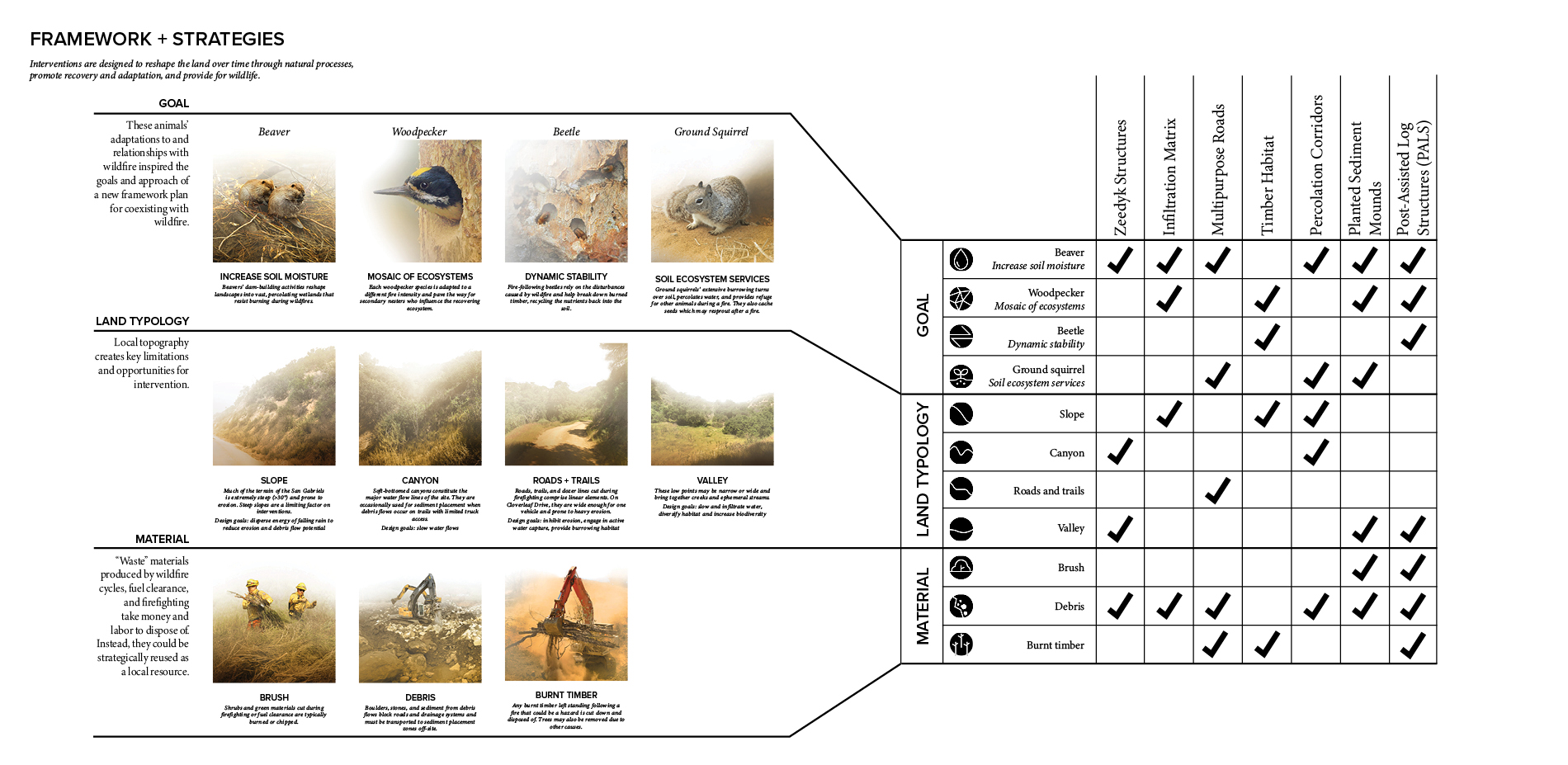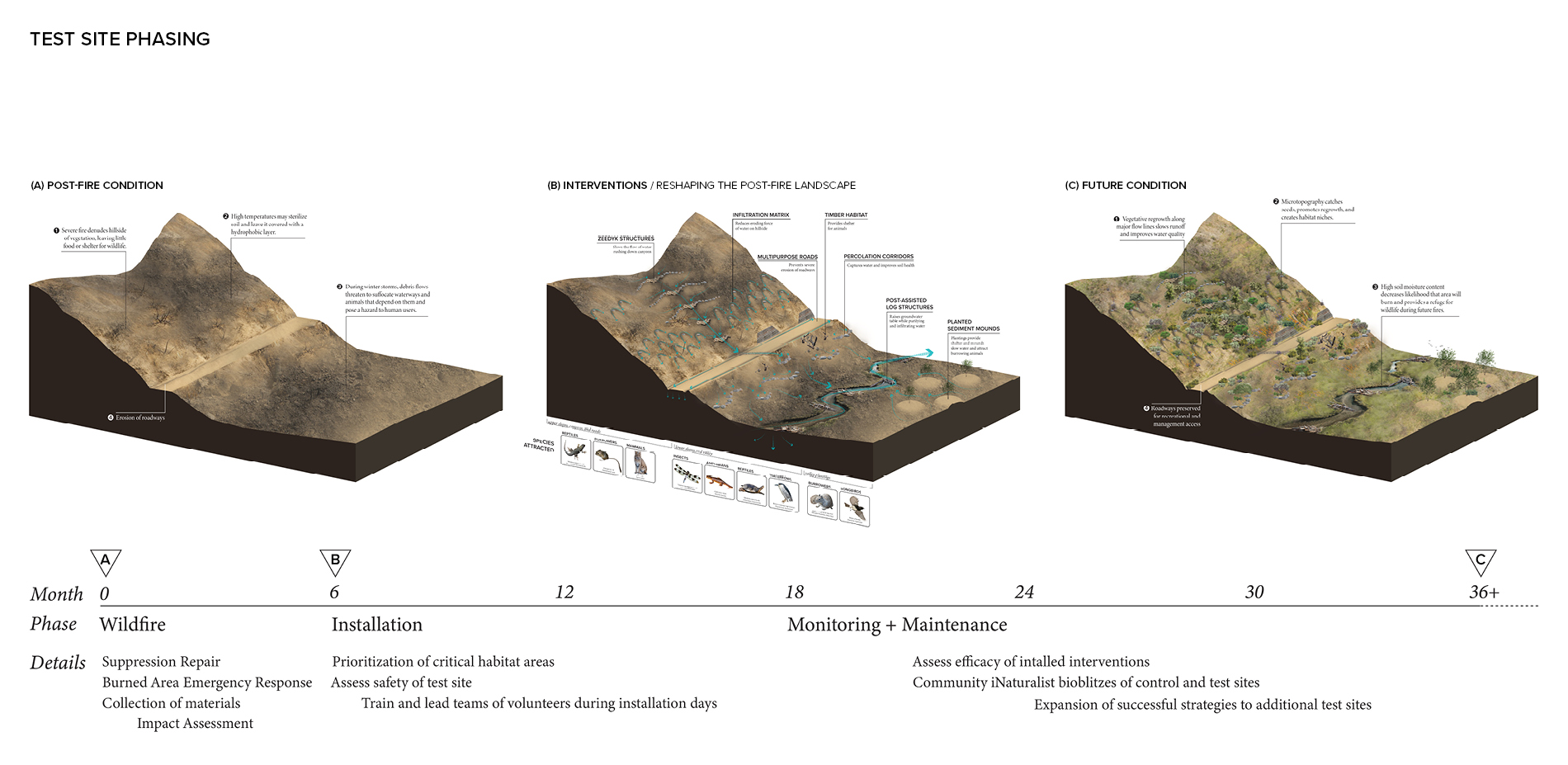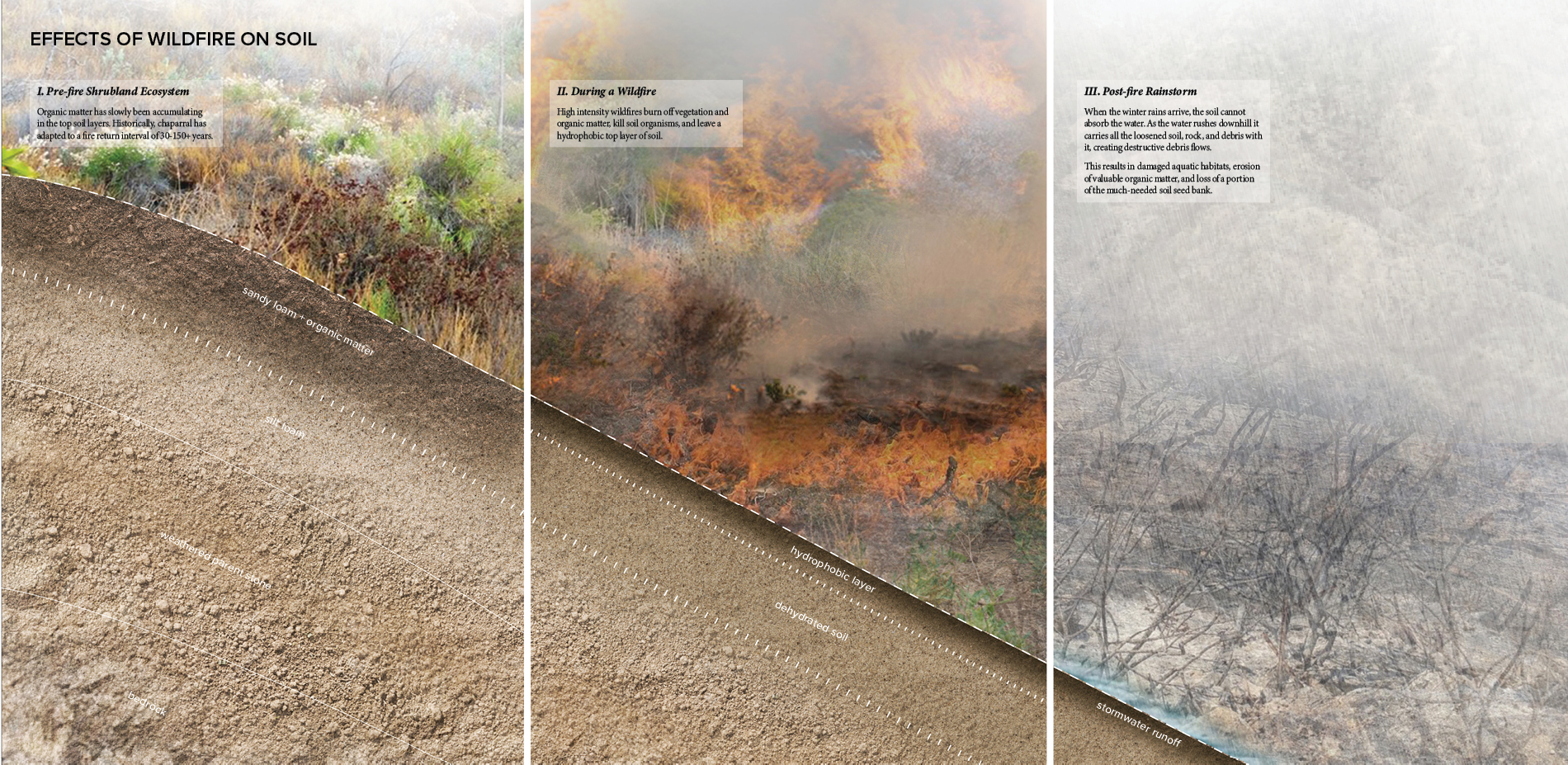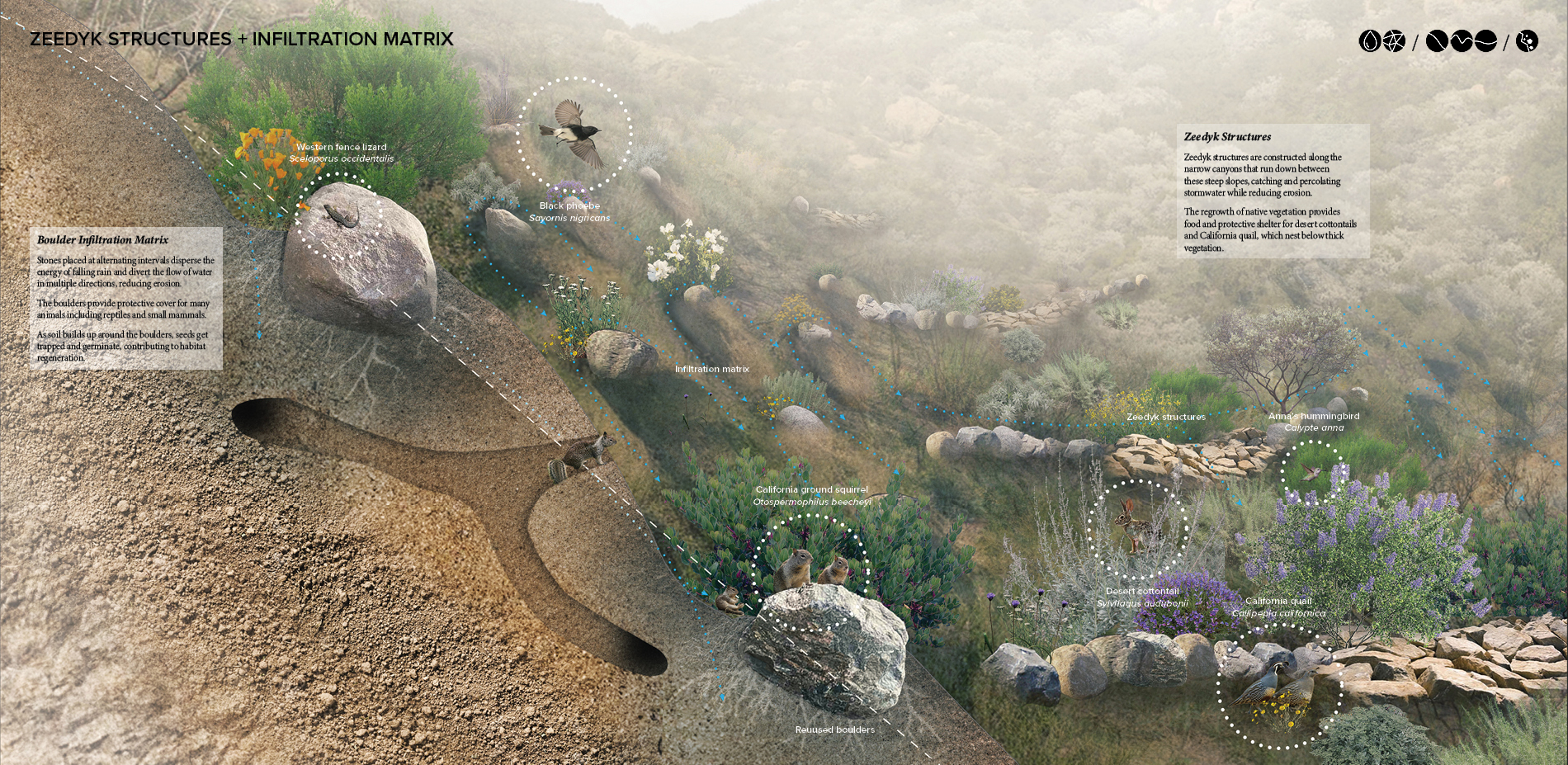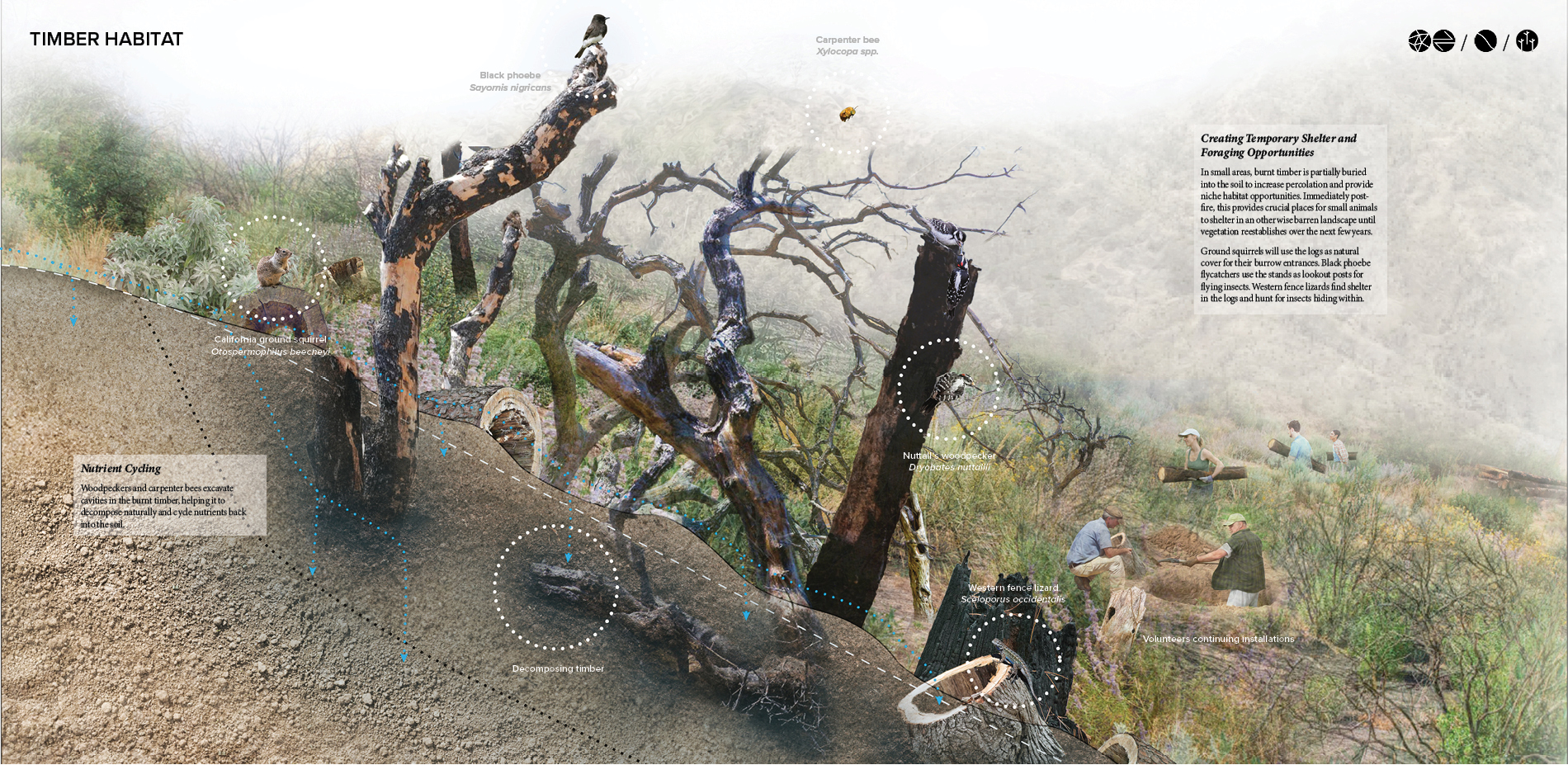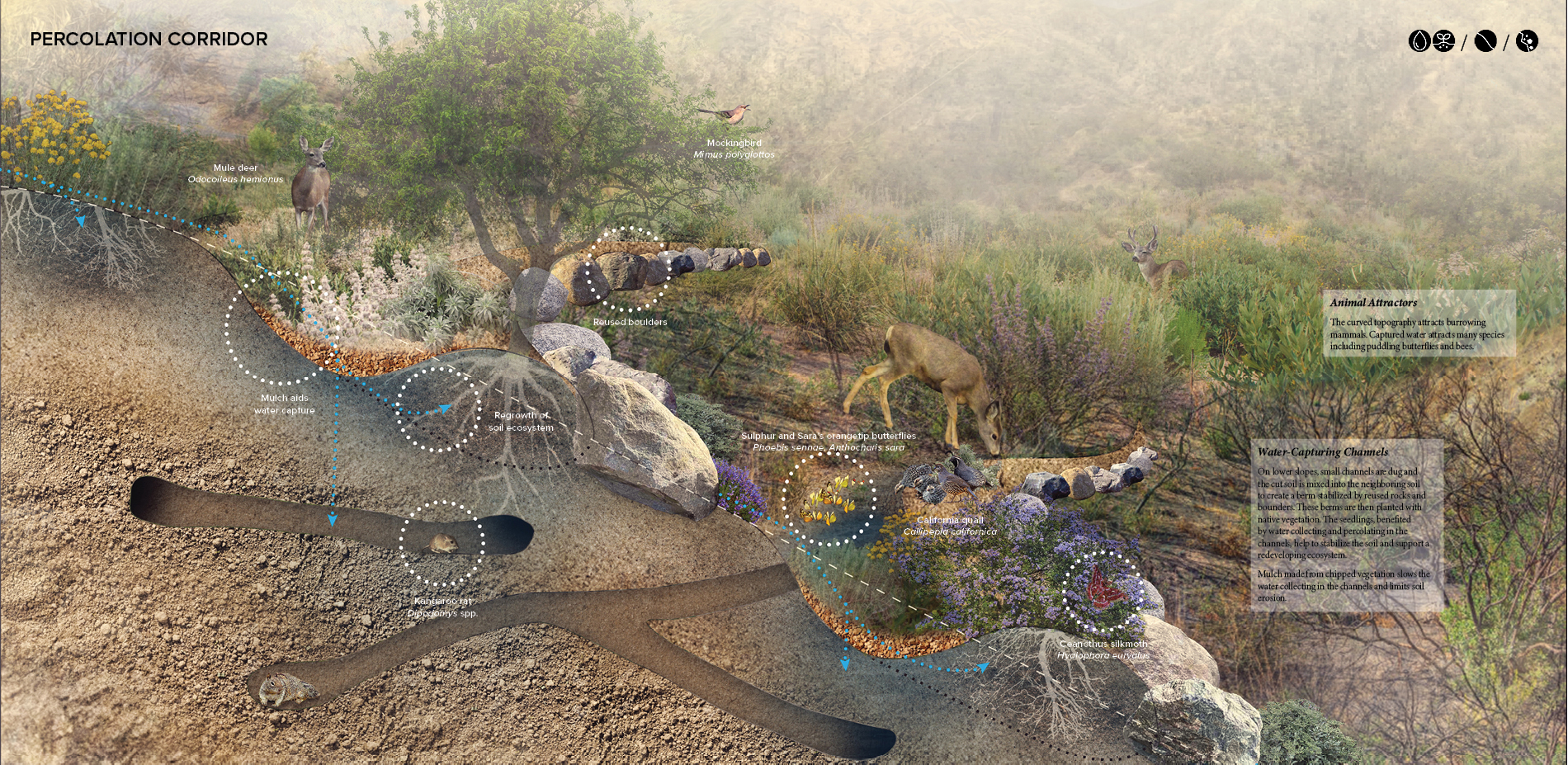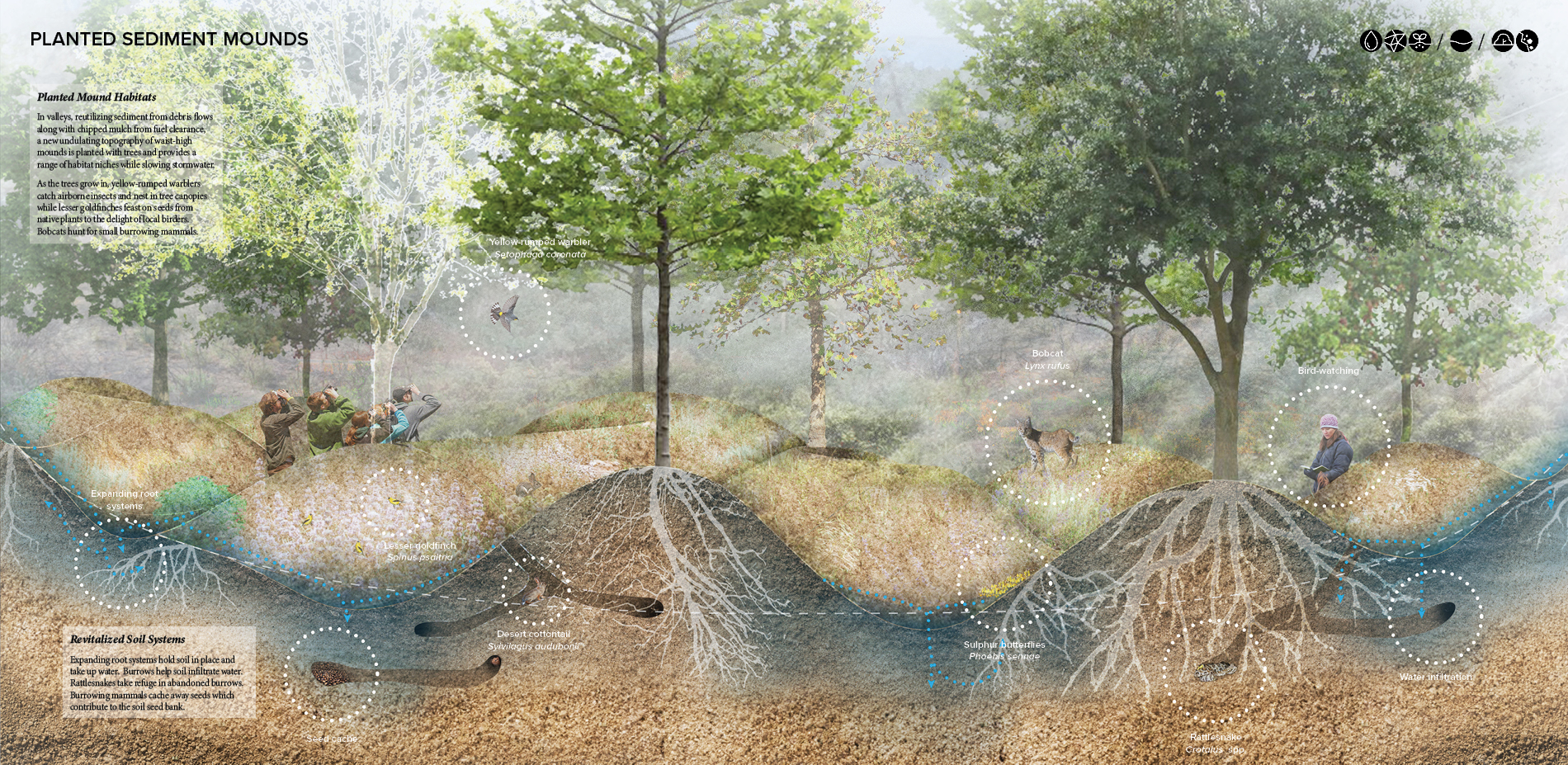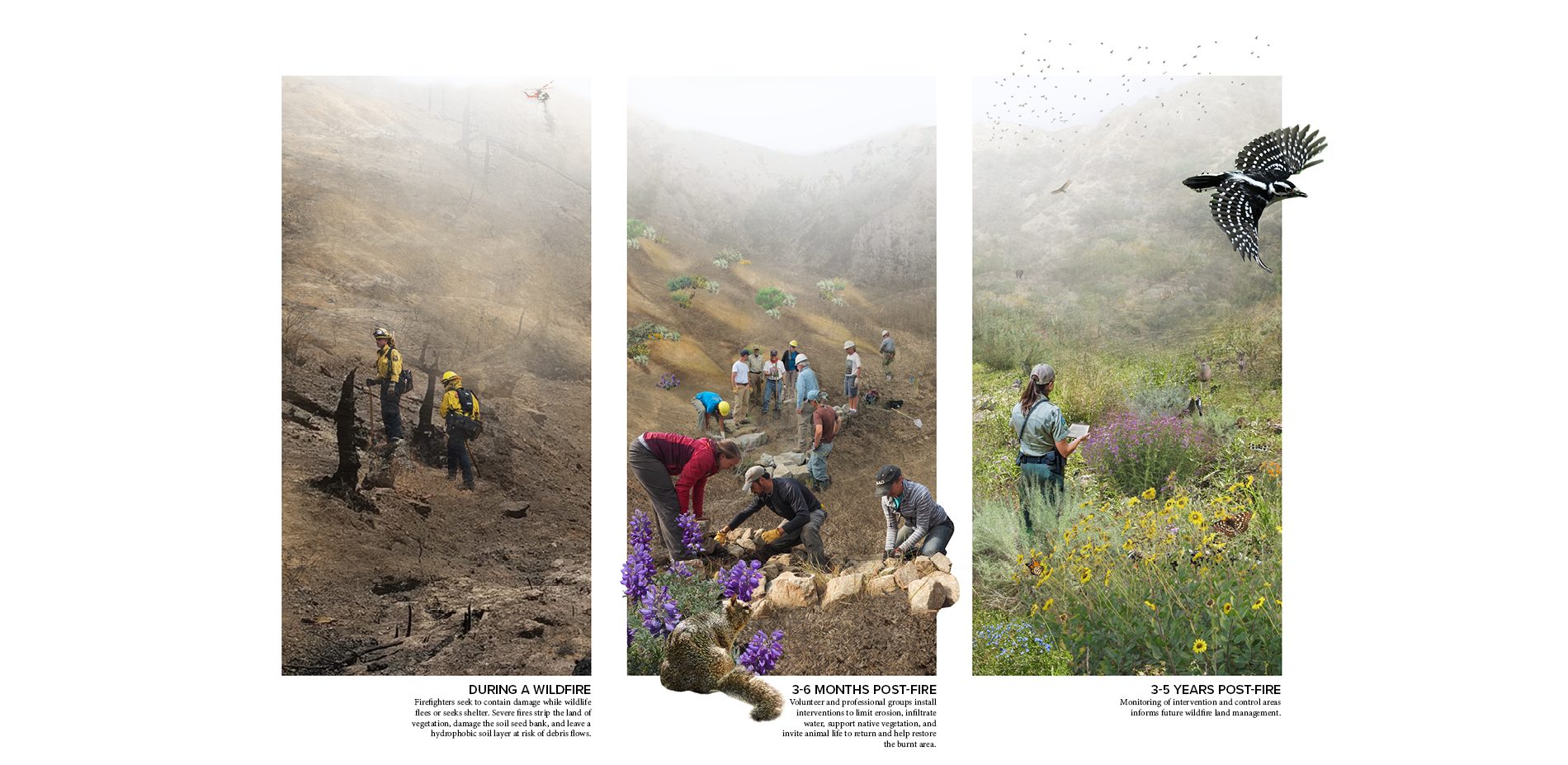Learning from Animal Adaptations to Wildfire
Honor Award
Analysis and Planning
Monrovia, California, United States
Andrea Binz, Student ASLA;
Diana Nightingale, Student ASLA;
Faculty Advisors:
Greg Kochanowski;
Aja Justine Bulla-Richards;
University of Southern California
Rather than taking a typical anthropocentric or environmental approach to addressing the growing wildfire threats that come with climate change, this innovative project proposes that we learn from the adaptive survival skills of wildlife. With well-conceived and beautifully rendered diagrams and vignettes, the proposal clearly outlines the challenges and proposes solutions that seem equally innovative and achievable.
- 2022 Awards Jury
Project Credits
Matthew Bokach
Monument Manager, Forest Service, San Gabriel Mountains National Monument
Mike Tramutola
Founder, Studio Supernatural
Project Statement
As wildfires in the San Gabriel Mountains become more frequent and severe, we need to expand our suite of management tools beyond firefighting and fuel clearance by seeking new inspiration. Around the world, wildlife have complex relationships and strategies for coexisting with wildfire. In this research project, animal adaptations to wildfire inform a land management framework designed to catalyze regeneration of habitat niches in post-fire landscapes to support ecological resilience. Framework goals include increasing soil moisture (BEAVER), developing a mosaic of ecosystems (WOODPECKER), promoting dynamic stability (BEETLE), and supporting soil ecosystem services (GROUND SQUIRREL). Interventions respond to local topography, strategically reuse materials produced by wildfire cycles and management, and engage forest management, residents, and volunteers in land care. The post-fire landscape is re-imagined as an opportunity to reshape the land over time through natural processes, promote recovery and adaptation, and provide for wildlife.
Project Narrative
Over the past century, wildfires have become more frequent and severe than the historical fire regimes of the San Gabriel mountains. Repeated fires cause biodiversity loss of fire-sensitive species, debris flows that clog creeks, and type conversion to non-native, flammable grasslands–leading to a supercharged fire cycle that will only worsen as climate change progresses. Currently, the main goals for managing wildfire are protecting communities and lives and reducing fire severity and frequency through firefighting, community hardening, fuel breaks, and fuel clearance. However, even with historic budgets, traditional management practices are struggling to keep pace with the increasing hazard. Furthermore, practices like prescribed burning that might be effective in other places may not be suitable for the unique ecosystems, notably chaparral, of Southern California. Therefore, it is imperative we seek new strategies to meet these environmental challenges.
During a year-long research and design inquiry, we started investigating wildlife adaptations to fire. We were amazed by the complex strategies that wildlife have developed around the world, from gopher tortoises whose deep burrows provide refuge during a fire to black kites that spread burning tinder to scatter prey. In California, species populations may benefit or suffer from wildfires depending on their individual habitat requirements. For example, while the kangaroo rat may actually benefit from a fire as they prefer a more open habitat, other animals such as the endangered red legged frogs may survive the fire in their aquatic habitats, but suffer from the debris flows that follow.
We started imagining, if we try to think like wildlife to understand their alternative ways of engaging with wildfire, how could we start to see the post-fire landscape as an opportunity? We focused in on four animals: the beaver, woodpecker, beetle, and ground squirrel. Although not native to the San Gabriel Mountains, beavers build dams that reshape landscapes into vast, percolating wetlands that resist burning during wildfires. Woodpeckers are some of the first animals to return to a burned site as they forage for beetles. They also create cavities later used by secondary nesters, helping to repopulate the recovering ecosystem. Fire-following beetles' reproductive cycles are timed with fire season, and they can sense smoke or heat from burning trees from 50+ miles away. Their tunneling activities help break down the burned timber and recycle nutrients back into the soil. Finally, ground squirrels' extensive burrowing turns over soil, captures and percolates water, and provides refuge for other animals during a fire. They also cache seeds, adding to the soil seed bank that sprouts following a fire.
These animals’ adaptations to and relationships with wildfire inspired the goals of a new framework for coexisting with wildfire by catalyzing regeneration of habitats niches to support ecological resilience. Framework goals include increasing soil moisture (BEAVER), developing a mosaic of ecosystems (WOODPECKER), promoting dynamic stability (BEETLE), and supporting soil ecosystem services (GROUND SQUIRREL). We then developed interventions that reshape the land over time through natural processes, promote recovery and adaptation, and provide for wildlife. These interventions respond to local topography while strategically reusing "waste" materials produced by wildfire cycles and management.
To identify a test site for our framework, we homed in on the Monrovia Hillside Wilderness Preserve, a beloved, community-managed preserve and hiking spot affected by the 2020 Bobcat Fire, one of the largest wildfires in Los Angeles County’s recorded history. The Bobcat Fire left in its wake debris flows, erosion, and burnt brush and timber that we could recycle into our strategies. At Cloverleaf Drive, which is easily accessible to pedestrians and vehicles, several key habitat types intersect, and there are a variety of topographic conditions and challenges representative of the San Gabriel Mountains.
Our plan engages key groups in the local community, including the City of Monrovia, which owns and manages the site, local fire departments, the Forest Service, the Rivers and Mountains Conservancy, and the California Botanic Gardens. Crucially, the region also has a large existing volunteer base ready to conduct installations and weekly management tasks. Interventions could be quickly and easily deployed by a team of volunteers led by park management over the course of a few months. In the subsequent monitoring and maintenance phase, biodiversity assessments of the test site interventions compared with a control site would inform the expansion of successful strategies to additional areas.
Analyzing a typical post-fire transect, severe fire denudes hillsides of vegetation, leaving little food or shelter for wildlife. Roads are prone to erosion. High temperatures may kill soil microorganisms and leave the earth covered with a hydrophobic layer prone to debris flows during winter storms, a major threat to downstream aquatic habitats for animals like the endangered mountain yellow-legged frog. Our interventions key into these issues, and together form a network of strategies that begin to reshape the land. The installations create habitat niches that support the return of a diverse and healthy ecosystem. Over time, vegetative regrowth along canyons and hillsides further aids in water capture and quality. Microtopographies enhanced by natural processes catch seeds and create habitat niches. Increased soil moisture, especially valley areas, decreases the likelihood the area will burn again and provides a refuge for wildlife during future fires.
Along steeper slopes and narrow canyons, zeedyk structures and boulder infiltration matrices slow water, reduce erosion, and help catch seeds that germinate and initiate regrowth of native flora. Multipurpose roads and trails are lined by bioswales that capture and infiltrate runoff into a percolating road typology. Steep slopes are braced by reused timber terracing to disperse the water runoff while creating nesting habitat. Berms enhance user safety while attracting burrowing animals whose tunnels increase percolation.
Downslope from the roads, installations of timber habitats are dug into the soil to increase percolation and serve as niche opportunities for animals returning to an otherwise barren landscape. As the wood breaks down, it absorbs water, returns organic matter to the soil column, and nourishes soil organisms while providing habitat for timber nesting and sheltering animals. Below the multipurpose roads, percolation corridors are created through small processes of cut and fill. Meandering berms are constructed with mixed soil, planted, and braced with reused boulders. The new topography collects water and attracts burrowing animals. And as plant roots expand, they hold soil in place, absorb additional water, and support a new soil ecosystem.
In the valleys, the huge amounts of soil and debris from debris flows could be reused to create winding, planted mounds that would slow and disperse fast-moving stormwater. As the plants grow, they will attract more wildlife while their roots stabilize the soil and absorb additional water. Also in the valleys, a sequence of post-assisted log structures could slow and infiltrate water during winter storms, raising the groundwater table and protecting the area from future burns. The widened stream enhances habitat for waterfowl while eddies and pools formed around the log structures create breeding habitat for animals like dragonflies and newts.
In this new framework for coexisting with wildfire systems, interventions respond to local topography, strategically reuse materials produced by wildfire cycles, and engage the community in land care. The post-fire landscape is re-imagined as an opportunity to reshape the land over time through natural processes, promote recovery and adaptation, and provide for wildlife.
Plant List:
- Manzanita (Arctostaphylos spp.)
- California sagebrush (Artemisia californica)
- Coyote brush (Baccharis pilularis)
- California lilac (Ceanothus spp.)
- California bush sunflower (Encelia californica)
- California poppy (Eschscholzia californica)
- Toyon (Heteromeles arbutifolia)
- Lupine (Lupinus spp.)
- California sycamore (Platanus racemosa)
- Coast live oak (Quercus agrifolia)
- White sage (Salvia apiana)
- Yucca (Yucca spp.)
